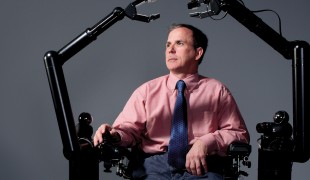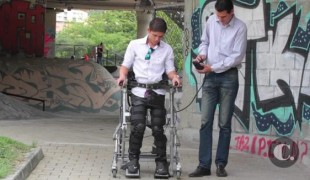- 8636
- 560
- 9
- 6
- 0
- Help Ukraine
About the solution
Built by a local welder with standard tools (no high tech), with local material (~ 50 Euro, except the rear wheelchair wheels) and tested by a 9-year old double amputee. All, organized, bought, built and tested, in only 3 days.
I got a mail from Kenya about “developing a low-cost, foldable, off-road wheel chairs for disabled children in rural Africa” at spring 2015.
That is why I got the idea with the wheelbarrow. Well, investigating, I saw a photo of a wheelbarrow race in Kenia :)
I think that this wheelchair could fulfill more ore less those points:
– low-cost (a wheelbarrow isn’t to expensive and if necessary second hand wheelbarrows could be used)
– off-road (the front wheel using the one of the wheelbarrow, the rear wheels (Try to get used ones, incl. the mounts) should be using mountainbike tires . The tube of wheelbarrows normally is very strong and made of steel, what makes it weldable!)
– for children (that is is the main point, as it is needed to know for whom it is, then you can bend the frame exactly for the needs)
– foldable (I thought attachable, if foldable is very important, I guess it is possible, but more expensive!)
Anyway, I liked my idea :)
The Building itself is to be seen in 4 parts:
The 2 main side tubes are looking a bit like short stairs. We use the wheelbarrows frametubes, cut them and together with flat steel we welded the new main tubes of the wheelchair. Important: we need to build 2 equal main tubes! (With better planing we wouldn’t cut all in pieces, just cut angles to bend)
As we don’t know the exact horizontal position of the big rear wheels, next we built the adjustment system to adjust and attach the big rear wheels. (This could be done cheaper and easier, too)
The struts to connect the 2 main tubes. We bent/welded flat steel, one behind the backrest and one under the seat base. As last strut we used 2 square tubes as footrest.
The front wheel gallows and the finishing, like side protection and seating base. The big wheelbarrow wheel can pass the most hurdles. So we just had to made sure it gets pulled. As the wheel uses an outer lane, it helps the wheelchair not to fall easy, when it turns. A metal sheet othe wheelbarrow tub and flat steel is used as side protection. And as seating and backrest base we used a rope.
We tried to build everything parallel and with the right (mostly) 90° angles, but as we hadn't the equipment therefor, it was not very exact.
As the wheelchair just works with 3 wheels and the seating base is a rope, it doesn’t matter to much. The chair works fine.
More about at http://santa66.net/
https://www.youtube.com/watch?v=aLwWYJGidyw&feature=youtu.be
This solution shall not include mention to the use of drugs, chemicals or biologicals (including food); invasive devices; offensive, commercial or inherently dangerous content. This solution was not medically validated. Proceed with caution! If you have any doubts, please consult with a health professional.
-
-
460
-
0
-
7374

Paralyzed man designs innovative wheelchairs
CAREGIVING
MOVING IN A WHEELCHAIR: Moving using a wheelchair.
Grip
Rubgy
Basketball
Paralysis
Cervical spinal cord injury/Tetraplegia
Assistive Daily Life Device (to help ADL)
Assistive Technology access
Walking Aid (wheelchair/walker/crutches)
Restoring mobility
Replacing lost limbs
Promoting self-management
Promoting inclusivity and social integration
Recovering from Traumatic Injuries
Preventing (Vaccination, Protection, Falls, Research/Mapping)
Caregiving Support
Neurology
Orthopedics
Physical Medicine and Rehabilitation
United States
-
-
-
455
-
0
-
6600

Visually impaired creates E-car to help the blind
MOVING IN A WHEELCHAIR: Moving using a wheelchair.
Traveling
Blindness
Paralysis
Cervical spinal cord injury/Tetraplegia
Walking Aid (wheelchair/walker/crutches)
Assistive Daily Life Device (to help ADL)
Vision problems
Paralysis of the legs and lower body
Restoring mobility
Promoting self-management
Promoting inclusivity and social integration
Preventing (Vaccination, Protection, Falls, Research/Mapping)
Neurology
Ophthalmology
Orthopedics
Germany
-
-
-
469
-
0
-
6691

Engineer develops low cost exoskeleton inspired by a friend
WALKING: Walking
MOVING IN A WHEELCHAIR: Moving using a wheelchair.
Spinal Cord and Nerve Root Disorders
Accident
Cervical spinal cord injury/Tetraplegia
Walking Aid (wheelchair/walker/crutches)
Assistive Daily Life Device (to help ADL)
Muscle cramps or spasms
Stiffness or rigidity (difficulty moving)
Paralysis of the legs and lower body
Muscle weakness
Restoring mobility
Promoting self-management
Managing Neurological Disorders
Promoting inclusivity and social integration
Preventing (Vaccination, Protection, Falls, Research/Mapping)
Neurology
Orthopedics
Colombia
-
 en
en